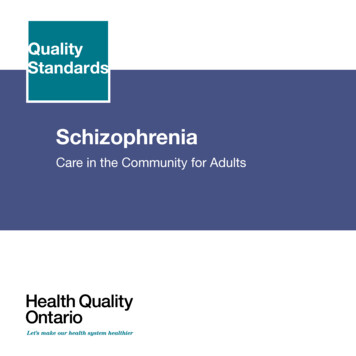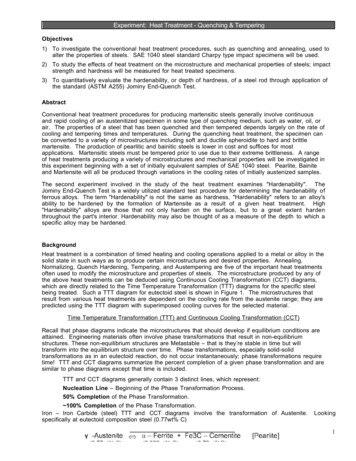
Transcription
Treatment HandbookBreast SurgerySurgery and RecoveryPatient & Family Support Services
Breast Cancer SurgeryPatient HandbookFaculty, staff, patients and family members provided information for this handbook:Comprehensive Cancer Center Breast Care Center, Hematology, Medical Oncology,Occupational Therapy, Patient Education, Patient and Family Advisory Board, PhysicalMedicine and Rehabilitation, Physical Therapy, Plastic and Reconstructive Surgery,Radiation Oncology, and Surgical Oncology
2BREAST CANCER SURGERY PATIENT HANDBOOK
Breast Cancer Surgery Patient HandbookTable of ContentsIntroduction7How to Call Your Health Care Provider8Important Phone Numbers8Who to Call/When to Call9What to do Before Your Appointment10Multidisciplinary Clinic and Tumor Board Conference11General Information - Breast Surgery at University of Michigan13Breast Anatomy, Breast Biopsy and Breast Cancer15Male Breast Cancer and Treatment Options19Treatment of Breast Cancer – Local and Systemic Therapy21Clinical Trials26Types of Breast SurgeryGeneral Surgery Information28Lumpectomy/Breast Conserving/Wire Localization29Sentinel Lymph Node Biopsy and Mapping37Total/Simple Mastectomy46Modified Radical Mastectomy48Skin Sparing Mastectomy49Nipple Sparing Mastectomy50Axillary Lymph Node Dissection56Breast ReconstructionGeneral Information on Breast Reconstruction63Immediate or Delayed64Implant64Natural Tissue65Nipple/Areola Reconstruction69BREAST CANCER SURGERY PATIENT HANDBOOK3
Preparing for SurgeryGeneral Information71Medications/Supplements to Avoid73Advance Directives78Preoperative Appointment79Preoperative Tips83Day of SurgeryHospitalization88Outpatient89Postoperative Instructions and CareDressings91Drains93Drain Removal97Exercises after SurgeryDeep Breathing99Posture100Arm and Shoulder103Shoulder Mobility108Increasing Activity116Swelling and Infection117Lymphatic System4Lymphedema118Risk Reduction120Skin Care123Signs of Lymphedema124Treatment for Lymphedema124Psychosocial Concerns125BREAST CANCER SURGERY PATIENT HANDBOOK
ResourcesAmerican Cancer Society’s Reach to Recovery126University of Michigan - Personal Touch 128University of Michigan Comprehensive Cancer Center’sPatient & Family Support Services129Web Sites130BREAST CANCER SURGERY PATIENT HANDBOOK5
6BREAST CANCER SURGERY PATIENT HANDBOOK
IntroductionIf you live with breast cancer or love someone with breast cancer you are partof a global community of women and men whose lives have been touched bythis diagnosis. With that diagnosis, your life has changed and the days aheadwill bring more changes and challenges.The doctors, nurses and other experienced health professionals at theUniversity of Michigan Breast Care Center created this handbook to help explainthe different surgical treatment options available to you as well as explain howto prepare for surgery and what to expect after surgery. Your medical team isavailable to help answer questions about this material and to help you decidewhich treatment options are right for you and give you the best chances ofcontrolling your cancer.Remember that medical knowledge concerning breast cancer treatment optionsis always advancing, so we will update you on the newest treatment optionsavailable.Because of advances in breast cancer detection and management, most patientswill be treated successfully!As you have just received a cancer diagnosis and are reading through thishandbook, you’re likely feeling overwhelmed. If so, you’re not alone – mostpatients and family members feel that way as they are introduced to the newconcepts, tools, techniques and resources involved in cancer treatment. Contactus as you make your treatment decisions. Important numbers follow.BREAST CANCER SURGERY PATIENT HANDBOOK7
How to Call Your Health Care ProviderMonday through Friday; 8:00 a.m. to 5:00 p.m., call the Breast Care Center at734-936-6000.Weekdays after 5:00 p.m., all weekends and holidays: contact the UM pagingoperator at: 734-936-6267 and ask to have the on-call Surgical OncologyResident paged.Before Surgery Phone NumbersBreast Care Center 734-936-6000Breast Imaging (Mammography) 734-936-6274Breast Surgery Clinic 734-936-6000Cancer Center Nutrition Clinic 877-907-0859East Ann Arbor Surgical Center734-232-3053East Ann Arbor Surgery Family Waiting Room734-232-3000Lymphedema Class Registration 877-907-0859Nuclear Medicine Department 734-936-5090Patient Education Resource Center734-647-8626Patient & Family Support Services877-907-0859Personal Touch Boutique 734-973-2400(Orthotics and Prosthetics Center)Plastic Surgery 734-998-6022Preoperative Center at Domino Farms734-936-3604Social Work 800-888-9825Surgery Cancellation Number 734-936-8800University Hospital Surgery Family Waiting Room8BREAST CANCER SURGERY PATIENT HANDBOOK734-936-4388
Who to Call after Surgery8:00 a.m. to 5:00 p.m., weekdays, refer to the Surgery Phone Number Sheet youreceived at surgery discharge for contact numbers during business hours.After 5:00 p.m. weekdays, weekends and holidays call: UM paging operator at734-936-6267 and ask to have the on-call Surgical Oncology Resident paged.When to Call Your Health Care ProviderContact your health care provider for any of the following reasons: Oral temperature of 101 degrees Fahrenheit or greater Persistent, severe or increasing pain Bleeding from the incision that is difficult to control with light pressure Persistent nausea or vomiting Fluid or drainage from the incision area 1 inch or more of redness around the incision area Incision that becomes warm or hot to the touch Foul odor from the incision area Swelling of the entire breast Leakage around your drainage tube and wet gauze dressing Any significant change that causes you concernBREAST CANCER SURGERY PATIENT HANDBOOK9
What to do before your visit to the Breast Care CenterHere are some things to think about and to organize before your visit to theBreast Care Center: Write down any questions to ask your doctor. Make a notebook (or folder) to file all of your notes and reports.For example, pathology reports, mammogram reports, etc. Bring a family member or caregiver or support person with you to yourappointments. Ask them to take notes on what is said.The information in this handbook will be reviewed and discussed throughoutyour treatment. Please bring this handbook with you to all appointments.You will find blank pages at the back of the handbook to use for questions,appointments or other notes.Consider joining the patient portal: MyUofMHealth.org. Throughthe portal you may securely access health information anywhere, atany time. With the portal you can message your care team, requestappointments and prescription refills, pay your bill and more.Do Not use the Patient Portal for medical emergencies!Call the Clinic if you have any symptoms that concern you.10BREAST CANCER SURGERY PATIENT HANDBOOK
University of Michigan Comprehensive Cancer Center Breast CareCenter Multidisciplinary Clinic and Tumor Board ConferenceAt the University of Michigan (UM), we strive to provide the best treatment andplanning approach for our patients by reviewing and discussing their medicalcondition and treatment options. This team approach (called multidisciplinarycare) is the foundation of our Breast Care Center (BCC). Breast cancer patientsundergoing evaluation at the UM BCC usually have all aspects of their case(breast imaging, clinical assessment, pathology/biopsy material) reviewedwhen our multidisciplinary group of breast cancer specialists (surgicalbreast oncologist, radiation oncologist, medical oncologist, radiologist andpathologist) meet.This BCC Multidisciplinary Tumor Board Clinic meets every Monday. Eachpatient receives the benefit of input from several experts in breast cancer care.Most patients with invasive breast cancer who are candidates for surgery will bescheduled for an initial full-day Monday clinic visit. We encourage you to bringone support person, be it a spouse, significant other, relative or close friend.Our BCC nurse clinic coordinators are also breast oncology experts who willwork with you in advance of Monday’s visit to gather as much information aspossible to prepare for the tumor board review.In the morning, you will undergo a complete clinical evaluation (history andphysical examination) as well as breast imaging consultation (which ofteninvolves repeat/updated mammography and/or breast ultrasound). In the earlyafternoon you’ll participate in a patient education class where our BCC staffwill present information on breast cancer treatment options and techniques formanaging stress and anxiety. You’ll also learn about resources that are availableto you and your family at the UMHS Comprehensive Cancer Center and withinyour community. While you are participating in this class, the BCC group ofBREAST CANCER SURGERY PATIENT HANDBOOK11
doctor-specialists will be meeting to discuss your case.In the afternoon, you’ll return to the clinic rooms where you will meet withone or more breast specialists to finalize your management plan. You maymeet with a plastic/reconstruction surgeon in the afternoon as well. You,and whoever accompanies you, should plan to spend most of your day atthe Monday BCC Multidisciplinary Clinic. We know this is a busy day, but itdoes cut down on multiple visits to consult with different specialists who areinvolved with your treatment plan. In addition, it ensures that all members ofthe treatment team are working in a coordinated way.If you require evaluation for cancer genetic profiling, you will need to schedulea separate consultation appointment with the breast oncology medical geneticsspecialists. The best known examples of inherited gene mutations whichincrease breast cancer risk are the breast cancer susceptibility genes BRCA 1and BRCA 2 (BReast CAncer genes 1 and 2). The profiling itself may take two tothree weeks to complete. Your treatment team will discuss whether this geneticprofiling information is recommended for your care.Many breast cancer patients receive multimodality care (surgery, medicaltreatment/chemotherapy, radiation) and often the results of one component ofcare will influence the plan for the subsequent type of care. In these situationsyou may require repeat evaluations at later Monday BCC Multidisciplinary Clinicand Tumor Board. If you are receiving breast cancer care through the Universityof Michigan BCC, your treatment team will guide you regarding when and howoften you need to be evaluated at the Monday BCC Multidisciplinary Clinic andTumor Board. Follow-up evaluations usually involve shorter visits, dependingupon the complexity of your individual case.12BREAST CANCER SURGERY PATIENT HANDBOOK
General Information Regarding Breast Cancer Surgery at theUniversity of MichiganYou will likely require at least one surgical procedure in the course of your care.While discussing many aspects of multidisciplinary breast cancer treatment,this guide focuses on the surgical component of your care. Your breast surgerymay be performed at University Hospital, East Ann Arbor Ambulatory SurgicalUnit or at some other surgical facility within the University of Michigan HealthSystem. Where your surgery is performed will depend upon the resources thatare necessary for your particular operation and surgical suite availability.Some procedures require the combined services of a surgical breast oncologist,breast radiologist and/or the plastic/reconstruction surgeon. Some operationsinvolve the use of pathology assessments during the surgery itself. This mayaffect your surgical plan. Your options will be discussed with you by yourtreatment team and reviewed when a final plan is decided.You may have a preoperative (before surgery) visit at a University of Michigan’sPreoperative Clinic. At this visit you will have a physical examination, reviewyour surgical plan and sign an informed consent document. If necessary, youmay also meet with an anesthesiologist. On the day of your surgery, you willhave a final brief preoperative conversation with your surgical and anesthesiateam.Your surgery incision and postoperative (after surgery) care may varydepending on your surgeon’s preferences, and she/he will discuss this withyou on the day of your surgery. The final results/pathology report from yoursurgical procedure will be available in two to five business days. You willreceive a telephone call from a member of your treatment team to explain theseresults, and at that time you will also make plans for your next BCC clinic visit.BREAST CANCER SURGERY PATIENT HANDBOOK13
Your results may be reviewed at the BCC Multidisciplinary Tumor Board. If youare a lumpectomy patient, it may also involve postoperative mammography.If you have undergone plastic/reconstruction surgery, you will have separatepostoperative visits with your plastic surgery team.We understand your desire to have as much information as quickly as possibleregarding the status of your breast cancer and recommended treatment plan.Please understand that our goal is to obtain a comprehensive assessment thatenables us to develop the best possible treatment options for your individualsituation.14BREAST CANCER SURGERY PATIENT HANDBOOK
Understanding the relationships between breast anatomy, breastbiopsy and a breast cancer diagnosisUnderstanding the normal anatomy of the breast is an important first step tounderstanding breast cancer and how it is treated.The purpose of the female breast is to produce milk. The breast is made up oflobules, which are milk glands that produce the milk, and ducts, which carrythe milk from the lobule to the nipple during lactation (when milk is beingproduced). Breast cancer can form either in the lobules or in the ducts. A cancerthat forms in the lobules is known as lobular carcinoma. A cancer that forms inthe ducts is known as ductal carcinoma.The ducts and lobules are connected like branches on a tree trunk, forming aclosed system of thousands of microscopic channels and tubules that extendthroughout the breast.A malignancy (cancer) involving cancerous cells that are confined to themicroscopic ductal and/or lobular structures is called in situ or non-invasivebreast cancer. When the cancer cells have disrupted the microscopic boundariesof the ductal and lobular channels, it is called invasive or infiltrating breastcancer. A breast biopsy involves taking a sample of breast tissue and having itanalyzed under a microscope by a specially trained doctor called a pathologist.The pathologist then provides a report about whether the sampled breast tissueis benign (non-cancerous) or malignant (cancerous). If the biopsy reveals cancer,then the pathologist also describes the pattern of the cancer and whether it isin-situ/non-invasive, invasive/infiltrating or a combination of both.The pathologist will also describe the microscopic pattern of a benign/noncancerous biopsy sample, as some patterns of benign breast tissue help us toBREAST CANCER SURGERY PATIENT HANDBOOK15
identify women that have an increased likelihood of developing breast cancer inthe future.In addition to many thousands of microscopic ductal and lobular units, thebreast is also comprised of fatty tissue, blood vessels and other drainagechannels called lymphatic vessels (See Figure 1). Invasive breast cancers arecapable of extending into these vascular and lymphatic drainage channels, withthe potential for spreading to other organs of the body. Extension of a cancerinto other organs beyond the breast is called metastatic spread.The nipple is centered in the areola, a dark area of skin in the middle of thebreast. A thick muscle (the pectoralis muscle, or “pec”) lies underneath thebreast, covering the ribs.Lymph is the fluid carried through the lymph node chains. It drains, or filters,the tissue of the breast, then passes through the lymph nodes, where it isfiltered again, then travels back into the blood stream. There are several areasor chains of lymph nodes that drain the breast. They are located on both sidesof your chest bone (internal mammary chain), under your arms (axillary chain)and above your collarbone (supraclavicular chain). Most of the breast is drainedinto the axillary lymph node chain under the arm, but occasionally they drain tothe other chains of lymph nodes.Lymph drains the breast tissue and is carried through the lymph nodes. Hereit is filtered for bacteria, cellular waste, and viruses before it can reach thebloodstream. Lymph nodes are an important part of your body’s defenseagainst infection.16BREAST CANCER SURGERY PATIENT HANDBOOK
Nipple-Areola ComplexLobulesLymph NodesMilk DuctsBreast TissueFigure 1: Image of breast tissue, chest wall muscles, lymph nodes, lobules,milk ducts and nipple-areola complexBREAST CANCER SURGERY PATIENT HANDBOOK17
Breast cancer cells can break off from the initial tumor and travel to other partsof the body through the lymph fluid (or the blood stream). Once in the lymphfluid, they pass through the lymph nodes and can get trapped. The presenceof cancer cells in lymph nodes is an indication that the cancer has the abilityto spread and is a more aggressive type of breast cancer. For this reason,examining the lymph nodes draining the breast in the armpit for breastcancer is an important step in the evaluation of breast cancer.In addition to evaluating the lymph nodes, we also look for clues regardingthe aggressiveness of the cancer by studying the size and microscopic patternof the tumor. Some patients will be candidates for an analysis of the geneticcontent of their cancer. This analysis is called an Oncotype Dx Recurrence Score.All of these clues help us develop a treatment plan designed to minimize thelife-threatening risk of breast cancer for each individual patient.We have made many advances in understanding the diverse biology of breastcancer. This has allowed us to tailor treatment and expand treatment options.As a result of these improvements, the majority of patients will be cancer-free,long-term survivors.18BREAST CANCER SURGERY PATIENT HANDBOOK
Male Breast CancerBreast cancer may occur in men. Men at any age may develop breast cancer, butit is usually found in men between 60 and 70 years of age. Male breast cancermakes up less than one percent of all cases of breast cancer in the UnitedStates.The following types of breast cancer are found in men: Invasive/Infiltrating ductal carcinoma: Cancer that has spread beyond thecells lining ducts in the breast. Most men with breast cancer have thistype of cancer. Ductal carcinoma in situ: Abnormal cells that are found in the lining of aduct; also called intraductal carcinoma. Inflammatory breast cancer: A type of cancer in which the breast looksred and swollen and feels warm. Paget disease of the nipple: A tumor that has grown from ducts beneaththe nipple onto the surface of the nipple.Survival for men with breast cancer is similar to that for women with breastcancer when their stage at diagnosis is the same. Male breast cancer can be asign of hereditary predisposition for cancer and indicates a need for geneticcounseling.Treatment and survival from breast cancer in men depends on the following: The stage of the cancer (whether it is in the breast only or has spread toother places in the body). The type of breast cancer. Estrogen-receptor and progesterone-receptor levels in the tumor tissue. Your age and overall health.BREAST CANCER SURGERY PATIENT HANDBOOK19
Treatment of breast cancer in menBecause there have been few clinical trials on the treatment of male breastcancer, most doctors base their treatment recommendations on theirexperience with the disease and on the results of studies of breast cancer inwomen. With some minor variations, breast cancer in men is treated the sameway as breast cancer in women.If you are of reproductive age and systemic therapy is being considered to treatyour breast cancer, talk to your doctors about fertility preservations options.Reproductive age usually begins in the teenage years. Some cancer treatmentsmay render patients infertile (unable to have children) and knowing about youroptions to preserve fertility, at an early time point in your treatment plan, mayallow the best chance to make an informed decision about this important issue.20BREAST CANCER SURGERY PATIENT HANDBOOK
Treatment of Breast CancerLocal and Systemic TherapyBoth local therapy and systemic therapy are used to treat breast cancer. Localtherapy treats the tumor in the breast only. Surgery and radiation therapy areexamples of local therapies. Systemic therapy is given by mouth or directlyinto the bloodstream to reach cancer cells that may have spread beyond thebreast. Chemotherapy and hormonal therapy, also called endocrine therapy, areexamples of systemic therapy.If you are pregnant or think you may be pregnant, tell your doctor right away.Women who are pregnant will have their surgical options carefully consideredin conjunction with other breast oncology specialists to develop an individualtreatment plan. Women who are pregnant cannot be given radiation while theyare pregnant.If you are of reproductive age and systemic therapy is being considered to treatyour breast cancer, talk to your doctors about fertility preservations options.For women, reproductive age begins with the onset of menses or “periods”(often in teenage years) and continues until about the early forties. Some cancertreatments may render patients infertile (unable to have children). Knowingabout your options to preserve fertility early in your treatment plan, may allowthe best chance to make an informed decision about this important issue.Reproductive specialists are readily available at the University of Michiganto discuss and provide fertility preservation options as part of yourmultidisciplinary treatment plan.BREAST CANCER SURGERY PATIENT HANDBOOK21
Usually, the first decision in the treatment of breast cancer is which type ofsurgery to pursue. This decision is made after careful examination of a numberof factors, including the following:Tumor type: Invasive or non-invasive? What is the microscopic pattern or cell type?Size of the tumor: Size is measured in centimeters and millimeters. One inchequals approximately 2.5 centimeters; 10 millimeters equals one centimeter.Some tumor sizes are estimated on the basis of a lump that can be felt onbreast physical examination. These are called palpable breast tumors. Somebreast cancers cannot be felt on breast physical examination. These are callednon-palpable but are found by mammography and/or breast ultrasound.In this case, the size of the tumor is determined by measurements provided bya radiologist. Often we combine the information found on clinical examinationand breast imaging to provide the most accurate information on the extent ofthe cancer in the breast.Location of the tumor: Where the cancer is located may impact the type ofsurgical options available to remove it, such as proximity to the nipple, to thechest wall muscles or to the axillary lymph nodes.Patient priorities: Which surgery offers the best chance for cure? Will reconstruction be considered? How do you feel about each surgical option?Prior cancer treatments: These treatments may influence surgical options for anew breast cancer diagnosis. For example, previous radiation treatments to the22BREAST CANCER SURGERY PATIENT HANDBOOK
chest wall/breast(s) can affect the breast surgery and reconstruction planningwhen a new breast cancer is diagnosed.Your health: Smoking affects recovery after surgery and, in some instances, theability to receive further treatment after surgery. If you smoke, talk to yourdoctor about a plan to help you stop. Support groups, medications and othermethods may help you quit. If you would like help to quit smoking or the useof other tobacco products, please call the MHealthy Tobacco ConsultationService at 734-998-6222 or visit, www.mhealthy.umich.edu/tobacco for moreinformation.Cosmetic results: Your breast cancer treatment team can tell you how yourbreast(s)/chest wall may look after you’ve had lumpectomy surgery andradiation, or mastectomy and/or breast reconstruction. Please keep in mindthat every person and procedure is unique and appearances will differ fromperson to person.These and other factors are important considerations for making surgicaldecisions. Surgical decisions have an impact on the type of therapy you willreceive later. Some surgeries are followed by radiation therapy, some bychemotherapy or hormonal therapy. Therefore, the surgical decision is madein combination with other specialists who will decide how best to treat yourcancer after surgery.Your medical team will review each of these factors in their discussions withyou. As a team, you will decide the best surgical method to treat your breastcancer.In the course of your breast cancer treatment planning, you will receive moreBREAST CANCER SURGERY PATIENT HANDBOOK23
information regarding systemic/medical therapy. This therapy is an essentialcomponent of the multidisciplinary management of patients diagnosedwith invasive breast cancer. As described earlier, invasive breast cancers areassociated with the possibility of metastatic spread to other organs in thebody (such as the liver, lungs, bones or brain). If your cancer appears to beassociated with risk for having microscopic disease in other organs beyond thebreast (called micrometastases), then we will give you medical treatments thatcirculate throughout the body, such as chemotherapy or endocrine therapy.The recommended treatment plan should destroy the spread and protect otherorgans in your body.Your treatment team will evaluate the many aspects of your breast cancer(size of the tumor, its microscopic pattern, genetic content or profile of thetumor and the involvement of axillary/underarm lymph nodes). This is doneto determine whether systemic medical treatment(s) are necessary, and if so,which type of treatment is appropriate. Patients with non-invasive breast cancermay not need systemic therapy.Some systemic medications target molecular markers that are associated witha certain type of breast cancer. For example, breast cancer that is hormonereceptor-positive (estrogen or progesterone receptor) will be treated withtamoxifen or aromatase inhibitor drugs. Other treatments target a markercalled HER2/neu. Chemotherapy treatments aim to kill any rapidly-dividingcells (such as cancer cells), and may be necessary either instead of, or inaddition to targeted therapy. The use of targeted therapy is an especiallypowerful strategy in breast cancer treatment and this is one of the manyreasons why your case will be carefully evaluated. This includes evaluating yourbreast cancer biopsy material (and its molecular markers) by a team of experts.For most breast cancer patients, final decisions regarding systemic therapy will24BREAST CANCER SURGERY PATIENT HANDBOOK
be made after reviewing the results of surgery performed on the breast and theaxillary/underarm lymph nodes. Systemic therapy that is given to the patientafter breast cancer surgery has been completed is called adjuvant therapy.In some patients, it is very clear at the time of diagnosis and before the surgerythat chemotherapy will be necessary. In these cases, you may have the optionof receiving the chemotherapy before undergoing definitive/final breast cancersurgery. This treatment is called preoperative chemotherapy, neo-adjuvantchemotherapy or induction chemotherapy.For patients that need chemotherapy as well as surgery for their breast cancer,it is important to complete all components of your care. Some patients havecancers that are very bulky, called Locally Advanced Breast Cancer (LABC).Preoperative chemotherapy is often the first choice in the treatment sequencefor LABC to improve the success and technical safety of the ultimate breastsurgery. In other cases, preoperative chemotherapy will be a treatment optionto shrink the primary tumor in the breast so that the patient will have a bettercosmetic outcome with lumpectomy (breast-conserving) surgery.BREAST CANCER SURGERY PATIENT HANDBOOK25
Clinical TrialsYour doctor may suggest that youthink about joining a clinical trial (aresearch study or protocol) for thetreatment of breast cancer. Clinicaltrials are one very importantFor more information on clinicaltrials visit: www.mcancer.orgor the Patient Education ResourceCenter on Level B2/ground floorof the Cancer Centerreason that the University ofMichigan Comprehensive CancerCenter is able to offer you access to the most advanced cancer treatments.Clinical trials are used to test new treatments. The goal of trials is to find waysto improve therapy or decrease side effects. While a trial or study is active,we will not know whether any improvement has been made. The trial must beclosed and the research analyzed before the results can be made available topatients.There may be some risks associated with clinical trials. Your doctor will discussthe potential risks and benefits with you and get your written consent beforestarting you on a research protocol.The University of Michigan Health System has an oversight committee thatconducts an extensive review of all clinical trials. These committees includean Institutional Review Board (IRB) made up of cancer doctors, doctors inother specialties and lay people. The IRB reviews all protocols before they areavailable to patients and again at different times during the research to be surethe protocol remains appropriate and safe for patients.If you are part of a clinical trial, you will receive the best care possible, and yourreactions to the treatment are watched closely. If the treatment doesn’t seemto be helping you, a doctor can take you out of a study. You may also choose to26BREAST CANCER SURGERY PATIENT HANDBOOK
leave the study at any time. If you leave the study, you will
Oral temperature of 101 degrees Fahrenheit or greater Persistent, severe or increasing pain . possible to prepare for the tumor board review. In the morning, you will undergo a complete clinical evaluation (his











